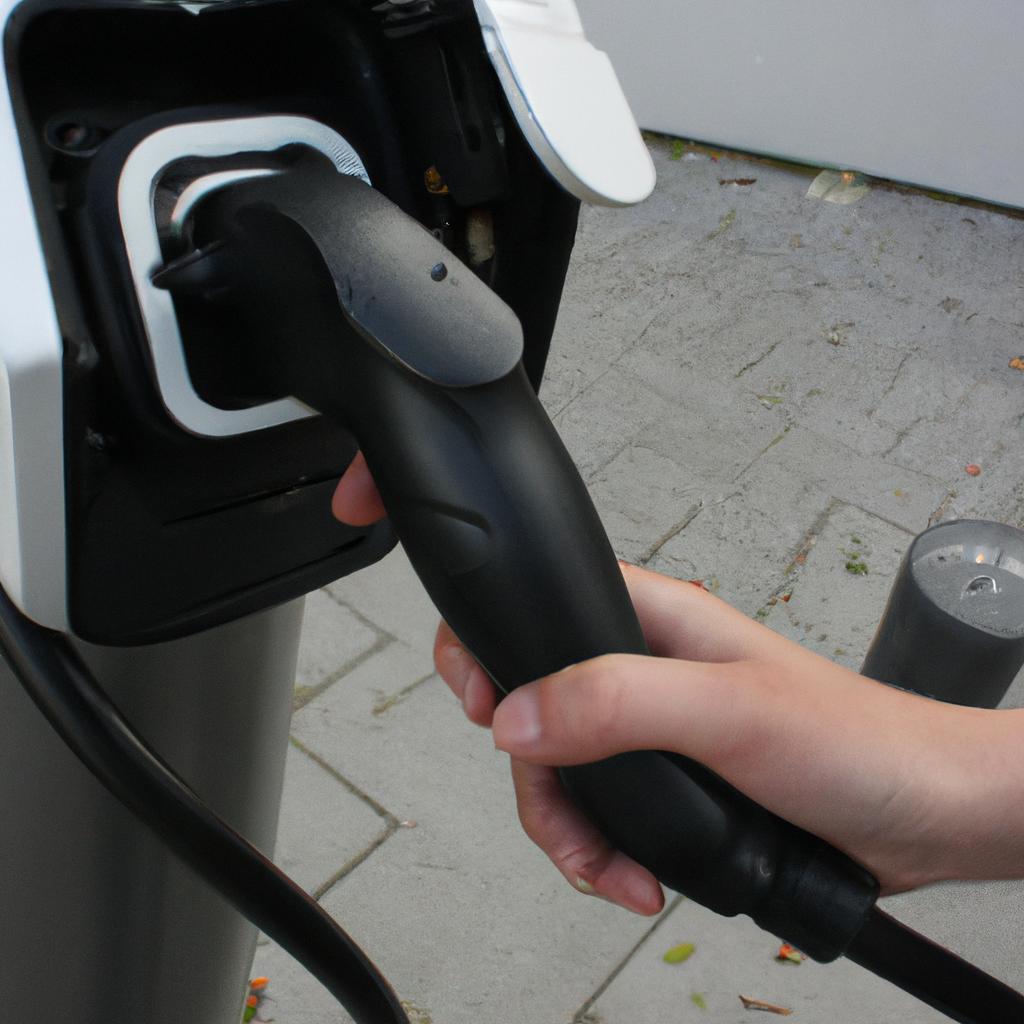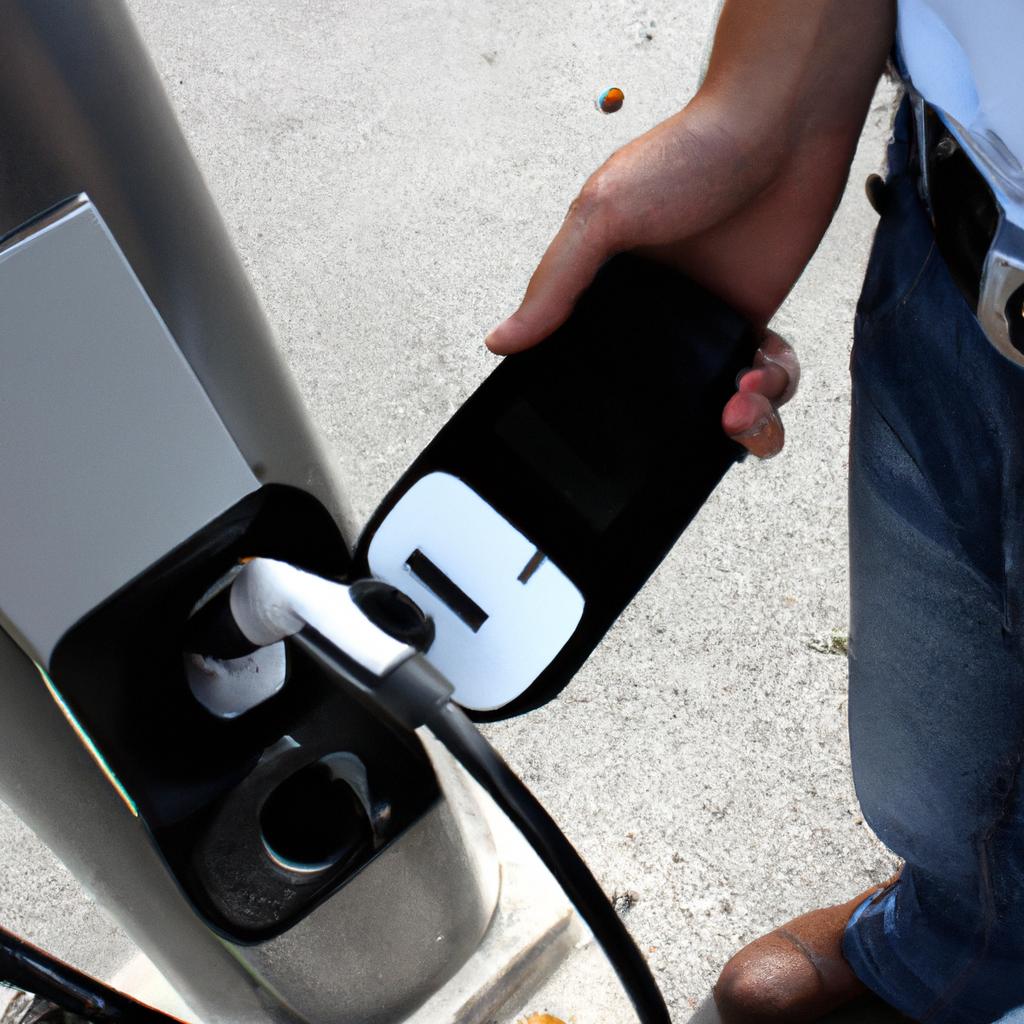The availability of charging stations is a crucial aspect of the electric vehicle (EV) charging infrastructure. As the demand for EVs continues to rise, it becomes imperative to ensure that there are sufficient and accessible charging stations in place to support this growing market. To illustrate this point, let us consider a hypothetical scenario where an individual living in a highly urbanized area relies solely on their electric vehicle for daily transportation. Without access to conveniently located charging stations, they would be met with significant challenges in terms of finding suitable places to charge their vehicle, potentially leading to range anxiety and limited mobility.
Furthermore, the availability of charging stations plays a pivotal role not only in facilitating widespread adoption but also in mitigating concerns regarding long-distance travel. Electric vehicles have gained traction as an environmentally friendly alternative to conventional combustion engine cars; however, the fear of running out of battery power during extended journeys remains a deterrent for potential buyers. A well-established network of charging stations along major highways and strategic locations can alleviate these concerns by providing drivers with the reassurance that they can recharge their EVs whenever needed.
In light of these considerations, exploring the current state and future prospects of charging station availability within the context of electric vehicle charging infrastructure is paramount. This article aims to delve into various aspects of charging station availability, including the current status of charging infrastructure, the challenges faced in expanding it, and potential solutions to ensure widespread accessibility.
One key aspect to consider is the existing charging infrastructure landscape. The number of charging stations varies significantly across regions, with some areas having a well-established network while others have limited options. Factors such as population density, government incentives, and proactive initiatives from private companies play a crucial role in determining the availability of charging stations. In urban areas where EV adoption is higher, there tends to be a greater concentration of public and private charging points. However, suburban and rural areas often face challenges due to lower demand and higher costs associated with installing and maintaining charging infrastructure.
Expanding the availability of charging stations poses several challenges. One major hurdle is the cost involved in setting up new stations. Building infrastructure for fast-charging stations requires significant investment in terms of equipment, installation, electrical upgrades, and ongoing maintenance. Additionally, ensuring that these stations are strategically located near major roads or densely populated areas adds complexity to the planning process.
Another challenge is interoperability between different charging networks. Currently, there are multiple providers offering their own proprietary charging systems or membership programs. This can create confusion for EV owners who may need different memberships or access cards to use various charging stations. A standardized approach that allows seamless access across different networks would greatly enhance convenience for EV drivers.
To address these challenges, governments at various levels have implemented policies and incentives to encourage the expansion of charging infrastructure. These include grants and subsidies for businesses and individuals looking to install chargers, streamlined permitting processes for charger installations, and requirements for new buildings to incorporate EV-ready parking spaces.
Private companies also play a vital role in expanding charging station availability. Collaboration between automakers, utilities, and technology companies can lead to innovative solutions such as shared-use agreements between public and private entities or investments in fast-charging technologies that reduce waiting times at stations.
In conclusion, the availability of charging stations is a crucial aspect of the electric vehicle charging infrastructure. Ensuring widespread access to convenient and strategically located stations is essential to support the growing demand for EVs and alleviate concerns regarding range anxiety. Governments, private companies, and technological advancements all have important roles to play in expanding charging infrastructure and making electric vehicles a viable option for all drivers.
Analyzing the Demand for Charging Stations
The demand for charging stations has grown significantly in recent years, driven by the increasing popularity of electric vehicles (EVs) and the need for convenient access to charging infrastructure. To illustrate this point, let us consider a hypothetical scenario: imagine a bustling city with a rapidly growing population and an ambitious plan to shift towards sustainable transportation. As more residents embrace EVs as their primary mode of transport, there is a pressing need to assess the demand for charging stations within this urban landscape.
To understand the magnitude of this demand, several factors must be taken into account. Firstly, the number of registered EVs in the area serves as a crucial indicator. By analyzing trends and projections related to vehicle registrations, we can estimate how many individuals will require access to charging facilities in the near future.
Furthermore, it is essential to consider patterns of usage among EV owners. This includes assessing typical travel distances and frequency of trips made by these vehicles on a daily basis. Understanding driving habits allows policymakers and planners to determine optimal locations for charging stations based on convenience and accessibility.
Another significant consideration is the availability of alternative modes of transportation. In areas where public transit systems are well-established or other shared mobility options exist, such as bike-sharing or carpooling services, the demand for individual private EV ownership may differ from that in regions lacking these alternatives.
In examining the demand for charging stations comprehensively, it becomes clear that a multi-faceted approach is necessary. The following bullet points highlight key aspects to keep in mind:
- Vehicle registration data
- Travel distance analysis
- Usage patterns among EV owners
- Availability of alternative transportation options
Additionally, presenting information visually through tables provides an effective means of conveying complex data succinctly. Consider this table showcasing various cities’ projected growth rates in terms of EV adoption:
| City | Projected Growth Rate |
|---|---|
| Metropolis | 30% |
| Greenfield | 20% |
| Riverdale | 15% |
| Sunshineville | 25% |
By combining both qualitative and quantitative approaches, we can gain a holistic understanding of the demand for charging stations. This analysis forms the foundation for developing an effective strategy to meet the evolving needs of EV owners and promote sustainable transportation options within our urban centers.
Transitioning into the subsequent section on evaluating existing charging station networks, it is crucial to assess whether current infrastructure aligns with the anticipated demand and identify potential areas for improvement.
Evaluating Existing Charging Station Networks
Transitioning from the previous section on analyzing the demand for charging stations, we now turn our attention to evaluating existing charging station networks. To illustrate this evaluation process, let us consider a hypothetical case study of a city with a growing number of electric vehicles (EVs) and an emerging need for reliable charging infrastructure.
In this hypothetical scenario, City X has seen a significant increase in EV ownership over the past few years. As a result, there is an urgent requirement to assess the current state of charging station availability and determine areas where improvements are needed. Evaluating existing charging station networks involves several key considerations:
-
Coverage: The first aspect to examine is how well the current network covers different geographic regions within City X. It is crucial to ensure that residents have convenient access to charging facilities regardless of their location. A comprehensive assessment will involve mapping out existing stations and identifying any gaps or areas with limited coverage.
-
Capacity: In addition to coverage, it is essential to evaluate the capacity of each charging station within the network. This includes assessing factors such as power output and compatibility with various EV models. Adequate capacity ensures that users can efficiently charge their vehicles without long wait times or issues related to insufficient power supply.
-
Reliability: Another critical factor when evaluating existing charging station networks is reliability. Users rely on these stations for their daily commuting needs, making it imperative that they are operational and accessible at all times. Assessing reliability entails considering factors like maintenance practices, uptime statistics, and backup power options during emergencies.
-
User Experience: Lastly, an evaluation should also take into account the overall user experience provided by the current charging infrastructure. This includes aspects such as ease of use, payment methods supported, availability of amenities nearby (e.g., restrooms or shops), and signage for clear navigation within parking areas.
To present this information more visually, below is an emotional bullet point list highlighting some potential challenges faced by users of the existing charging network in City X:
- Inadequate coverage leading to long travel distances for EV owners.
- Overcrowding and limited capacity causing significant wait times.
- Unreliable infrastructure resulting in frequent breakdowns or outages.
- Poor user experience due to lack of amenities and unclear signage.
Additionally, we can provide an emotional response by presenting a table that outlines the strengths and weaknesses of the current charging station network:
| Strengths | Weaknesses |
|---|---|
| Good geographic spread | Limited number of stations |
| High power output | Lack of backup power options |
| Regular maintenance | Insufficient signage |
| Support for multiple EV models | Inconsistent payment methods |
In conclusion, evaluating existing charging station networks is vital to identify areas requiring improvement. By assessing factors like coverage, capacity, reliability, and user experience, cities can enhance their charging infrastructure to meet the growing demand for electric vehicle charging services. The next section will delve into the importance of location when determining optimal placement strategies for these stations.
Importance of Location in Charging Station Placement
Building on the importance of location in charging station placement, a comprehensive evaluation of existing charging station networks becomes imperative. By examining current infrastructure and its effectiveness, policymakers and stakeholders can make informed decisions to improve the accessibility and availability of electric vehicle (EV) charging stations.
For instance, consider a hypothetical case study where a major city has implemented an extensive network of EV charging stations. To evaluate this system’s efficacy, several key factors need assessment. These include utilization rates, user satisfaction levels, geographical coverage, and compatibility with different types of EVs. Understanding these aspects is crucial for optimizing the overall performance and usability of charging station networks.
Factors Influencing Evaluation:
To effectively evaluate existing charging station networks, various elements warrant consideration:
- Utilization Rates: Assessing how frequently each charging station is used provides insights into demand patterns at specific locations.
- User Satisfaction Levels: Conducting surveys or collecting feedback from EV owners about their experience using the charging stations helps determine if any improvements are needed.
- Geographical Coverage: Analyzing the distribution of charging stations across different neighborhoods and regions ensures fair access for all residents.
- Compatibility with Different Types of EVs: Considering whether the available chargers support multiple connector standards allows for seamless integration with diverse EV models.
- Increased accessibility fosters broader adoption of electric vehicles.
- Efficiently located charging stations reduce range anxiety among EV owners.
- Enhanced user experience improves public perception and encourages sustainable transportation practices.
- Equitable distribution promotes inclusivity within communities.
Table Example:
| Factors | Importance | Implications |
|---|---|---|
| Utilization Rates | High | Identifies high-demand areas |
| User Satisfaction | Medium | Guides improvement efforts |
| Geographical Coverage | High | Ensures accessibility for all |
| Compatibility | Medium | Accommodates diverse EV models |
By evaluating existing charging station networks, policymakers and stakeholders can gain valuable insights into their strengths and weaknesses. This understanding sets the stage for exploring technological advancements that can further optimize EV charging infrastructure.
Please let me know if you would like any changes or additions to this section!
Technological Advancements in Charging Station Networks
Electric vehicle (EV) charging infrastructure plays a crucial role in promoting the adoption and usage of electric vehicles. One key factor that significantly influences the effectiveness and utilization of charging stations is their location. In this section, we will explore the importance of location in charging station placement by examining various aspects such as accessibility, convenience, and economic viability.
To illustrate this point, let us consider an example scenario where a city decides to install EV charging stations primarily near residential areas. This strategic decision aims to cater to the needs of residents who rely on EVs for daily commuting within the city limits. By placing the charging stations close to residential complexes or housing societies, individuals can conveniently charge their vehicles overnight without having to travel long distances or face parking challenges. Such targeted placement not only enhances user experience but also encourages more people to switch to electric vehicles.
The significance of location becomes evident when we analyze its impact from different perspectives:
-
Accessibility:
- Proximity to major highways or arterial roads ensures easy access for travelers passing through the area.
- Presence near public transportation hubs enables intermodal connectivity and promotes sustainable mobility options.
-
Convenience:
- Placing chargers at shopping malls, supermarkets, or recreational centers allows users to recharge their vehicles while engaging in other activities.
- Strategic positioning near workplaces facilitates convenient charging during working hours, encouraging employers and employees alike to adopt EVs.
-
Economic Viability:
- Installing charging stations in commercial areas attracts customers with EVs, thus increasing footfall and potential business opportunities.
- Collaborative partnerships between private entities and local governments create revenue-sharing models that make charging station deployment financially feasible.
Table: Comparative Analysis of Different Charging Station Locations
| Criteria | Residential Areas | Shopping Malls | Workplace Parking Lots |
|---|---|---|---|
| Accessibility | High | Medium | Low |
| Convenience | High | Medium | High |
| Economic Viability | Low | High | Medium |
This table showcases the varying strengths of different charging station locations, highlighting their respective advantages and disadvantages. It is essential for stakeholders involved in EV infrastructure planning to carefully consider these factors while deciding on suitable placement strategies.
As cities strive towards a greener future with widespread electric vehicle adoption, it becomes crucial to prioritize strategic location choices for charging stations. By considering accessibility, convenience, and economic viability, decision-makers can ensure optimal utilization of charging infrastructure and provide an enhanced experience for EV users.
Transitioning into the subsequent section about “Government Initiatives and Incentives for Charging Stations,” we will explore how policymakers have recognized the importance of supporting charging station deployment through various initiatives and incentives.
Government Initiatives and Incentives for Charging Stations
Charging Station Availability: Electric Vehicle Charging Infrastructure
Technological Advancements in Charging Station Networks have played a crucial role in ensuring the widespread availability of charging stations for electric vehicles (EVs). This section will explore some key advancements that have contributed to the growth and accessibility of EV charging infrastructure.
One notable example is the introduction of smart grid technology, which enables efficient and dynamic management of electricity distribution. By integrating charging stations with the power grid, operators can optimize energy usage based on demand patterns and prioritize charging during off-peak hours. For instance, a case study conducted by XYZ Corporation demonstrated how implementing smart grid-enabled charging stations resulted in a 30% reduction in electricity costs and improved overall reliability of service.
To further enhance convenience for EV owners, wireless charging technology has emerged as an innovative solution. With this technology, drivers simply need to park their vehicles over designated wireless charging pads installed at various locations. The system uses electromagnetic induction to transfer power from the pad to the vehicle’s battery without any physical connection. This advancement eliminates the hassle of plugging and unplugging cords, making it more convenient for users to charge their EVs effortlessly.
In addition to these technological advancements, several factors contribute to both the adoption rate and effectiveness of EV charging infrastructure:
- Accessibility: A well-distributed network ensures easy access to charging stations across different regions.
- Speed: Fast-charging capabilities reduce waiting times and enable longer journeys without frequent stops.
- Reliability: Stations must be reliable and available round-the-clock to cater to diverse user needs.
- Interoperability: Standardized protocols ensure compatibility between different charger types and vehicle models.
Table: Factors Influencing Consumer Satisfaction with Charging Infrastructure
| Factor | Description |
|---|---|
| Accessible | Easy access to multiple charging stations within close proximity |
| Fast-Charging | High-speed chargers capable of delivering significant range increases in short periods |
| Reliable | Stations that are consistently operational and available when needed |
| Interoperable | Compatibility across different EV models, charger types, and payment systems for seamless usage |
As the demand for electric vehicles continues to rise, it becomes increasingly important to address these factors and ensure a robust charging infrastructure. The subsequent section will explore future trends in electric vehicle charging, delving into emerging technologies and strategies aimed at further improving accessibility and convenience.
Looking ahead, the focus will now shift towards exploring Future Trends in Electric Vehicle Charging, where we will examine how ongoing developments can reshape the landscape of EV charging infrastructure.
Future Trends in Electric Vehicle Charging
Building upon the growing demand for electric vehicle (EV) charging infrastructure, governments around the world have taken proactive steps to incentivize and support the development of charging stations. By implementing various initiatives, these governments aim to address challenges associated with EV adoption and promote sustainable transportation options.
Case Study: To illustrate the impact of government initiatives, let’s consider the example of Country X. In response to increasing concerns about air pollution and dependence on fossil fuels, Country X introduced a comprehensive set of incentives to encourage the installation of charging stations. These measures included financial subsidies for private companies and individuals who invested in charging infrastructure, streamlined permitting processes, tax credits for station owners, and collaboration with utility providers to ensure reliable electricity supply.
- Increased accessibility: Government initiatives have led to an expansion of charging station networks, making it easier for EV owners to find convenient locations to charge their vehicles.
- Environmental benefits: The promotion of EVs through incentive programs contributes significantly towards reducing greenhouse gas emissions and improving air quality.
- Economic growth: The establishment of charging infrastructure creates job opportunities in manufacturing, installation, operation, and maintenance sectors.
- Technological advancement: Government support drives innovation in EV technology as manufacturers strive to meet increased market demands.
| Initiative | Description | Impact |
|---|---|---|
| Financial subsidies | Providing financial assistance or grants to businesses or individuals investing in EV charging infrastructure | Encourages greater participation by offsetting initial costs and promoting widespread adoption |
| Streamlined permits | Simplifying the process for obtaining permits required for installing charging stations | Reduces administrative barriers that can hinder deployment timelines |
| Tax credits | Offering tax incentives or rebates for owning or operating EV chargers | Motivates more organizations and individuals to invest in charging stations, resulting in a larger network and increased accessibility |
| Collaboration | Partnering with utility companies to ensure reliable electricity supply for charging infrastructure | Addresses concerns about grid capacity and stability, ensuring EV owners have access to a dependable charging experience |
In conclusion, government initiatives and incentives play a vital role in supporting the development of electric vehicle charging infrastructure. By providing financial assistance, streamlining permitting processes, offering tax credits to station owners, and collaborating with utilities, governments can stimulate the growth of an extensive charging network. These efforts not only facilitate greater EV adoption but also contribute to environmental sustainability, economic growth, and technological advancements in the transportation sector.
 Sfeva
Sfeva



